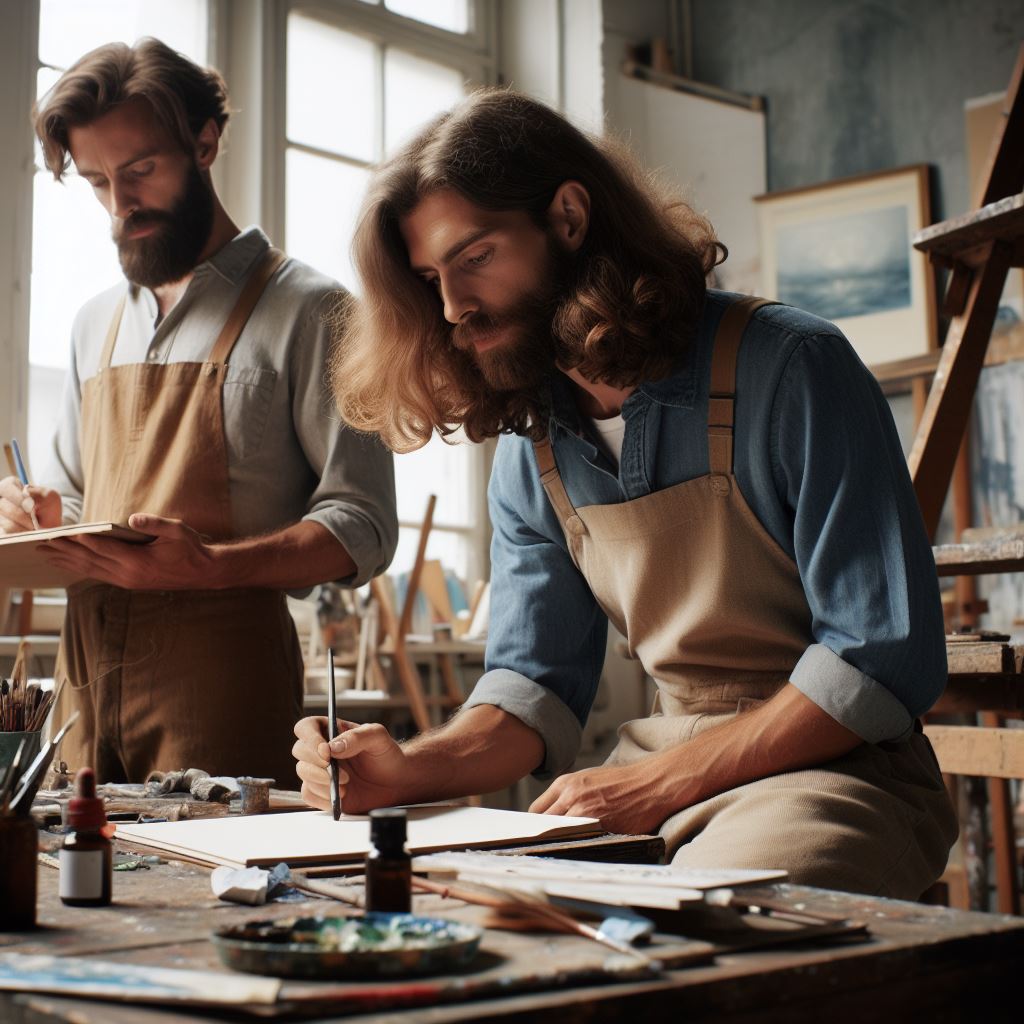Introduction
The art industry in the UK has been instrumental in producing renowned artists, leaving a lasting impact on society.
With a rich history of artistic achievements, the UK has nurtured many famous artists who have left an indelible mark.
These artists, through their creativity and talent, have not only entertained but also provoked thought and challenged societal norms.
The art industry in the UK has provided a platform for artists to express their ideas, emotions, and perspectives.
Art has the power to transcend boundaries, making it a powerful tool for communication and self-expression.
Moreover, the art industry has significant economic implications as it contributes to the country’s overall GDP.
The success of UK artists has not only brought international recognition but has also helped shape the cultural landscape of the nation.
Iconic figures such as William Hogarth, J.M.W. Turner, and David Hockney have greatly influenced the art world.
Their contributions have inspired upcoming artists and created a rich legacy that continues to thrive today.
The UK art industry continues to flourish, with contemporary artists like Tracey Emin and Damien Hirst pushing boundaries.
Furthermore, the UK hosts prestigious art institutions, museums, and galleries that showcase and preserve the nation’s artistic heritage.
The art industry plays a crucial role in both shaping the identity of the UK and contributing to its cultural and economic prosperity.
Historical Overview of Famous UK Artists
Art has been an integral part of the United Kingdom’s culture throughout history. From the early periods to the modern era, prominent artists have emerged, leaving a lasting impact on the art world.
In this section, we will discuss some of the most significant UK artists from different historical periods.
William Hogarth (1697-1764)
One of the most influential figures in British art, William Hogarth was a renowned painter and printmaker.
He is known for his satirical and moralizing works, which provided a unique social commentary during the 18th century.
Hogarth’s style combined realism with a sense of storytelling, often capturing scenes from everyday life.
Some of his notable works include “A Rake’s Progress” and “Gin Lane,” which depicted the negative impacts of vice and immorality.
J.M.W. Turner (1775-1851)
Joseph Mallord William Turner, commonly known as J.M.W.
Turner, was a prolific landscape painter who played a crucial role in the development of Romanticism in art.
His works often showcased the beauty and power of nature, with dramatic lighting and atmospheric effects.
Turner was an expert in capturing the transient qualities of light and weather, creating evocative and emotional landscapes.
Some of his famous pieces include “The Fighting Temeraire” and “Rain, Steam, and Speed – The Great Western Railway.
Personalized UK Career Consulting
Receive tailored career guidance designed just for you. Get actionable steps and expert support to boost your career in 1-3 days. Take control of your career now.
Get StartedJohn Constable (1776-1837)
John Constable was a renowned English landscape painter, known for his realistic and detailed depictions of the countryside.
His works celebrated the beauty of the English countryside and expressed a deep appreciation for nature.
Constable’s style emphasized meticulous observation and a keen sense of light and color.
He was a significant influence on the development of Impressionism.
One of his most famous paintings is “The Hay Wain,” which depicts a rural scene with a horse-drawn cart crossing a river.
These artists, along with many others, have made indelible contributions to the world of art.
Their works continue to inspire and influence artists even today.
In short, the UK has a rich history of notable artists who have shaped the course of art movements and left a lasting legacy that continues to resonate with audiences worldwide.
Read: UK Writers’ Tax Guide: Essentials
Transition to Contemporary UK Artists
The shift towards contemporary art in the UK
In recent years, there has been a noticeable shift towards contemporary art in the UK.
This shift can be attributed to several factors, including changing societal values and a desire for more diverse and innovative artistic expressions.
One reason for the transition to contemporary art in the UK is the changing societal values.
People are no longer solely interested in traditional art forms; they crave something new and unconventional.
Contemporary art offers a fresh perspective and challenges traditional ideas, making it more appealing to a modern audience.
Moreover, the rise of technology and globalization has influenced the diversity of artistic styles and mediums in modern times.
Artists now have access to a wide range of tools and materials, allowing them to explore different artistic techniques.
From digital art to installation art, the possibilities are endless. Contemporary UK artists are also known for their ability to push boundaries and tackle pressing social issues.
They use their art as a platform for activism and change.
Through thought-provoking and impactful works, they shed light on topics such as climate change, social inequality, and mental health.
One prominent contemporary UK artist is Damien Hirst. He gained fame in the 1990s for his controversial artworks, including a preserved shark in formaldehyde.
Hirst’s art challenges conventional notions of beauty and raises questions about the value of life and death.
Another notable artist is Tracey Emin.
Her artwork often revolves around deeply personal and autobiographical themes, exploring subjects such as love, sexuality, and female identity.
Emin’s work is raw and emotive, resonating with a wide audience.
The diversity of artistic styles and mediums in modern times
In addition, the diversity of artistic styles and mediums in contemporary art is evident in the works of Chris Ofili.
He combines traditional painting techniques with unconventional materials, such as elephant dung and glitter.
Ofili’s art is a unique blend of cultures and influences, reflecting the multicultural society of modern-day UK.
The emergence of street art has also contributed to the diversity of contemporary art in the UK.
Artists like Banksy have gained international recognition for their politically-charged graffiti and stencil artworks.
Street art brings art directly to the public, challenging the notion of elitism in the art world.
Contemporary UK artists are not limited to a specific style or medium.
They embrace experimentation and embrace a wide range of materials, including recycled objects, industrial materials, and even sound and video installations.
This diversity allows for endless possibilities and encourages artists to continuously explore and innovate.
In nutshell, the transition to contemporary art in the UK signifies a departure from traditional artistic forms and a desire for new, innovative expressions.
This shift is influenced by changing societal values, technological advancements, and the desire for diversity and inclusivity.
Contemporary UK artists continuously push boundaries, tackle social issues, and experiment with various styles and mediums.
Their art reflects the diverse and ever-evolving nature of modern society.
Read: Managing Change: A UK Director’s Toolkit
Insights into Famous Contemporary UK Artists
Overview of well-known contemporary UK artists
In the vibrant and dynamic world of contemporary UK art, several artists have emerged as groundbreaking and influential figures.
These artists have not only made significant contributions to the art world but have also captured the public’s imagination with their unique styles and thought-provoking themes.
Let’s take a closer look at some of these famous contemporary UK artists and explore their artistic journey.
Artists such as Damien Hirst, Tracey Emin, and Banksy
Damien Hirst
Damien Hirst is perhaps one of the most controversial and iconic figures in the contemporary art scene.
Known for his provocative installations and unconventional use of materials, Hirst has pushed the boundaries of artistic expression.
His theme of mortality and the human condition is apparent in works like “The Physical Impossibility of Death in the Mind of Someone Living,” featuring a preserved shark.
Tracey Emin
Tracey Emin is celebrated for her deeply personal and autobiographical approach to art.
Through mediums such as installations, paintings, and neon sculptures, she explores themes of love, sexuality, identity, and vulnerability.
Emin’s artwork often evokes strong emotional responses from viewers, blurring the line between art and life.
Banksy
Banksy, an anonymous street artist, has gained worldwide recognition for his politically charged and socially critical artwork.
Operating under a shroud of secrecy, Banksy’s stenciled graffiti pieces often confront established power structures and challenge societal norms.
His thought-provoking creations can be seen on walls around the world, delivering powerful messages through art.
Grayson Perry
Grayson Perry, a Turner Prize-winning artist, is known for his exploration of themes such as identity, class, and gender.
Perry’s ceramic artworks often combine traditional craft techniques with contemporary imagery and social commentary.
He challenges conventional ideas and stereotypes, stimulating conversations about society and culture.
Rachel Whiteread
Rachel Whiteread is renowned for her innovative approach to sculpture. She is best known for her casting technique, where she creates solid replicas of empty interiors or objects.
By preserving and immortalizing negative spaces, Whiteread challenges our perception of the everyday and invites us to reconsider the unseen and unnoticed.
Anish Kapoor
Anish Kapoor is famous for his large-scale sculptures that play with form, color, and materiality. His work often explores the concepts of space, light, and the sublime.
Kapoor’s pieces, such as “Cloud Gate” in Chicago’s Millennium Park, captivate viewers with their reflective surfaces and ability to distort and transform the surrounding environment.
Your Dream Job Starts with a Perfect CV
Get a tailored CV and cover letter that captures your unique strengths and stands out in your industry. Let us help you make an unforgettable first impression.
Get StartedCornelia Parker
Cornelia Parker is known for her visually striking and conceptually rich artworks.
She often uses found objects or materials with historical significance to create thought-provoking installations and sculptures.
Through her work, Parker challenges our understanding of familiar objects and invites us to see them in a new light.
Their unique styles, themes, and contributions to the art world
These UK artists have reshaped the contemporary art landscape through their distinctive styles, innovative techniques, and powerful themes.
Their contributions have not only enriched the art world but also sparked critical discussions about society, politics, and the human experience.
Whether through controversial installations, intimate autobiographical works, or politically charged street art, these artists continue to inspire and provoke, leaving a lasting impact on the art world.
Read: Crisis Management Strategies for UK Directors

Delve into the Subject: Navigating UK’s Acting Industry: A Beginner’s Guide
Impact of Famous UK Artists on the Global Art Scene
When it comes to the art world, the United Kingdom has produced some of the most influential and renowned artists throughout history.
From painters to sculptors, the impact of UK artists on the global art scene has been significant. Let’s analyze their influence and recognition internationally.
Analyze the Influence and Recognition of UK Artists Internationally
UK artists have long had a substantial influence on the global art scene.
Their unique perspectives and innovative techniques have captivated audiences worldwide. Artists like J.M.W.
Turner, John Constable, and David Hockney have left an indelible mark on the art world.
These artists’ works have been exhibited in prestigious galleries across the world, including the Louvre in Paris, the Metropolitan Museum of Art in New York, and the Tate Modern in London.
Their paintings and sculptures have received critical acclaim and continue to inspire contemporary artists.
Art movements such as the Pre-Raphaelite Brotherhood, the YBAs (Young British Artists), and the London School have also gained international attention.
The diverse range of styles and themes explored by UK artists has contributed to the global art discourse.
Exhibitions, Awards, and Critical Acclaim Received by Famous UK Artists
The exhibitions showcasing the works of famous UK artists have drawn immense crowds and received rave reviews.
Major retrospectives have been organized to honor and celebrate their contributions to the art world.
For instance, the Turner Prize, one of the most prestigious awards in contemporary art, has recognized the talent and innovation of UK artists since 1984.
This award has brought international attention to emerging artists and has become a barometer for artistic excellence.
Additionally, UK artists have been recipients of various other prestigious awards such as the Royal Academy’s Summer Exhibition, the John Moores Painting Prize, and the BP Portrait Award.
These accolades have not only elevated their status within the UK but also internationally.
Mention the Role of UK Art Schools in Nurturing Talent and Producing Renowned Artists
The UK’s art schools have played a vital role in nurturing talent and honing the skill of aspiring artists.
Institutions such as the Royal College of Art, Central Saint Martins, and the Slade School of Fine Art have produced some of the most influential artists of our time.
These art schools provide a platform for students to explore their creativity, experiment with different mediums, and develop their artistic voice.
They also encourage students to engage in critical discourse, pushing the boundaries of artistic expression.
Furthermore, the UK’s art schools have fostered a sense of community among artists, allowing for collaboration and collective growth.
Many renowned artists have emerged from these institutions, establishing the UK’s reputation as a hotbed for artistic talent.
In fact, the impact of famous UK artists on the global art scene cannot be overstated.
Their influence and recognition internationally can be seen through their exhibitions, awards, and critical acclaim.
Moreover, the role of UK art schools in nurturing talent has been instrumental in producing renowned artists.
The UK’s artistic legacy continues to inspire and shape the art world.
Read: The Role of Non-Executive Directors in the UK
Conclusion
The famous UK artists have played a significant role in shaping the history of art.
They have left a lasting impact on the global art landscape, with their innovative ideas and unique styles.
Optimize Your LinkedIn for Success
Boost your LinkedIn profile with a professional bio, keyword-rich headline, and strategic recommendations that attract recruiters. Stand out from the crowd and get noticed.
Optimize NowOver the years, these artists have contributed greatly to the development and evolution of art.
They have pushed boundaries, challenged norms, and inspired generations of artists to come.
Furthermore, contemporary UK artists continue to make noteworthy contributions to the art world.
Their works reflect the current social and cultural context, addressing pertinent issues and sparking important conversations.
These artists are carrying forward the legacy of their predecessors, while also carving their own path.
The ongoing contributions of UK artists ensure that the art scene remains dynamic and relevant.
Their work continues to captivate audiences and provoke emotions, reflecting the ever-changing nature of society.
In the end, the famous UK artists from the past and present have left an indelible mark on the art world.
Their contributions have been invaluable and have shaped the course of art history.
The global recognition and admiration for UK artists reaffirm their lasting impact and influence on the art landscape.
[E-Book for Sale]
500 Cutting-Edge Tech Startup Ideas for 2024 & 2025: Innovate, Create, Dominate
$19.99 • 500 Tech Startup Ideas • 62 pages
You will get inspired with 500 innovative tech startup ideas for 2024 and 2025, complete with concise descriptions to help you kickstart your entrepreneurial journey in AI, Blockchain, IoT, Fintech, and AR/VR.




